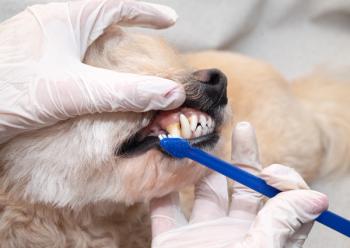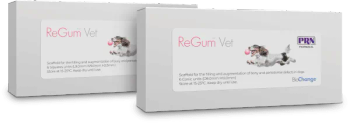
Take dental homecare for your patients to the next level
Most pets will benefit from a yearly dental cleaning and oral examination under anesthesia. When patients are discharged following a professional dental cleaning, a home-care program should be part of the take-home instruction sheet.
Most pets will benefit from a yearly dental cleaning and oral examination under anesthesia. When patients are discharged following a professional dental cleaning, a home-care program should be part of the take-home instruction sheet.
Daniel T. Carmichael
Daily tooth brushing is the best thing you can recommend for pet owners to do at home to promote good oral hygiene.
The goal of dental home care is to retard the accumulation of plaque and calculus on the tooth surface. Plaque bacteria can colonize on teeth in a period of 24 hours to 36 hours. This means that within a few days following a professional dental cleaning, the pet's teeth are already starting to accumulate the bacteria that will cause periodontal inflammation and disease again.
Figure 1: Dental homecare for the veterinary patient starts in the hospital. Painful, diseased teeth must be treated or extracted prior to commencing the homecare program.
Getting started
Dental home care for the veterinary patient starts in the veterinary hospital (Figure 1). Patients must be evaluated for the presence of dental disease and treated, if necessary, prior to beginning a home care program. The fact is that 85 percent of dogs more than age 3 and at least 50 percent of cats have significant periodontal disease that requires professional treatment. Professional dental treatment, performed when needed and under general (inhalant) anesthesia is the cornerstone of preventive dental health for our patients. On average, dogs and cats benefit from an annual prophylaxis starting at age 3, but each patient requires an individualized dental program. Ideally, dental homecare programs should be started with the puppy or kitten. If your patient is already at an age where dental pathology has set in, then it still is never too late to start.
Figure 2: Owners should be taught how to brush their pet's teeth. Establishing a daily tooth-brushing ritual will promote good oral hygiene and also will foster a human-animal bond of caring and trust.
What to recommend
Clients should be advised to brush those teeth every day.
Figure 3: Owners should brush in a circular motion while concentrating on the buccal surfaces of the teeth for about 30 seconds on each side.
Daily tooth brushing is the best thing you can recommend for pet owners to do at home to promote good oral hygiene. A daily tooth brushing is necessary because plaque bacteria can colonize on teeth in a period of 24 hours to 36 hours.
Figure 4: There are chew toy-type products on the market today that are not recommended due to their tendency to cause tooth fractures. Products such as "nylon bones", cow hooves, and "real bones" are too hard and often are associated with slab fracture of the carnasial teeth.
Owners should be taught how to brush their pet's teeth. (Figure 2, ) To start, place a small amount of toothpaste on the finger and let the pet sniff it and lick it. Always recommend pet toothpaste and discourage the use of human toothpaste. Next, gently rub some of the toothpaste on the teeth. Concentrate on the buccal surfaces of the teeth. (Figure 3, ) Go slowly and be patient. If things aren't going well, then wait until a few hours have gone by before trying again. When the pet has accepted the toothpaste by finger, it's time for the brush. A conventional toothbrush (children's—soft bristle) works well, or perhaps a finger brush will be less intrusive. The toothbrush should be held at a 45-degree angle to the tooth surface with the bristles pointing toward the gingival margin. This allows the cleaning of the gingival sulcus during the tooth-brushing process. Work the toothbrush in a circular motion, while concentrating around the canine tooth and upper fourth premolar tooth. Try for 30 seconds on each side of the mouth.
Feed a dental diet
There are several commercial diets that have been scientifically researched and shown to reduce plaque and tartar significantly when compared to "regular" dry food diets. This isn't just marketing hype—studies document significant reduction in the plaque index for the foods tested.
Do You Know the VOHC
Specifically these foods are Iams Daily Dental Care, Hills T/D (prescription diet) and Oral Care, and (for cats) Friskies Dental Diet. With the incidence of periodontal disease so high in dogs and cats, there are few reasons why anyone would not want to provide a diet that promotes good oral health.
Chew toys
Offer appropriate chew toys.
Rawhide treats for dogs are readily available to pet owners and are effective in the control and removal of plaque and tartar from dog's teeth. Rawhide is highly digestible, and has not been observed to cause the digestive problems that conventional wisdom ascribes to them in the numerous scientific studies documenting its effectiveness. It has also been shown that coating rawhide treats with calcium-sequestering substances, such as sodium hexamethaphosphate, can further enhance plaque and tartar reduction. Various types and designs of compressed rawhide, including the popular Greenies (S&M Nutec) also help promote good oral health.
Increase dental compliance one step at a time
There are chew toy-type products on the market today that are not recommended due to their tendency to cause tooth fractures. Such products as "nylon bones" cow hooves and "real bones" are too hard and can be associated with slab fracture of the carnasial teeth.
Tennis balls are notorious for causing attrition (mechanical wearing of the surface) and should be avoided, too (Figure 4).
Other products
Chlorhexadine (CET rinse and CET gel, Virbac; Nolvadent, Fort Dodge), formulated as an oral rinse or a gel is an excellent oral disinfectant. The chlorhexadine will bind to gingival tissue and then can exert its antibacterial effects during a 24-hour to 48-hour period. Chlorhexadine kills the bacterial pathogens that contribute to periodontal disease and halitosis. In chronic cases of periodontitis, instruct owners to use to chlorhexadine twice a week, combined with regular tooth brushing on the other days.
Other oral rinses, that contain substances such as zinc ascorbate (Maxigard, Addison Labs) or chlorine dioxide (Pet oral hygiene solution, Oxyfresh), work well for combating halitosis by their neutralizing effect on malodorous sulfur compounds. It is important to realize that masking halitosis doesn't address the primary source of oral pathology.
There is a relatively new product, OraVet (Merial) that bonds to the surface of teeth and inhibits plaque and calculus adherence. OraVet initially is applied in the veterinary clinic following a dental prophylaxis, but it must be used at home once a week to continue its efficacy.
Newsletter
From exam room tips to practice management insights, get trusted veterinary news delivered straight to your inbox—subscribe to dvm360.






